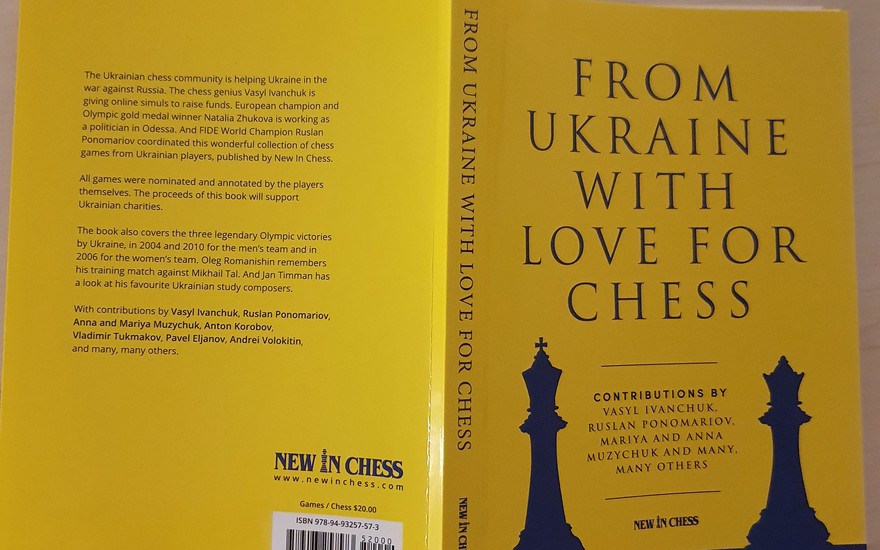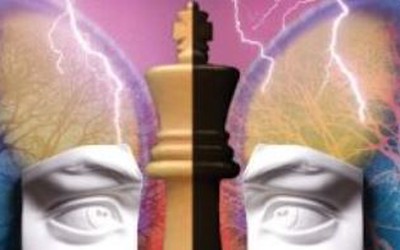
Book Review: From Ukraine with Love for Chess
This is a review by FM James Vigus of From Ukraine with Love for ChessFrom Ukraine with Love for Chess
Contributions by Vasyl Ivanchuk, Ruslan Ponomariov, Mariya and Anna Muzychuk and many, many others
207 pages, New in Chess 2022
Sample pages available on the publisher's website
Usually I read books thoroughly before posting a review, but I'm making an exception in offering an 'instant' review of this one.
The proceeds are being donated to Ukranian charities. According to the preface by New in Chess's Remmelt Otto, Steve Giddins translated the book without payment and the printers printed it at a large discount. Readers are promised an update on the fundraising achieved in several months' time.
The cause is therefore well worth supporting. But what kind of book is it?
From Ukraine with Love for Chess is a celebration of outstanding Ukranian chessplayers. The majority of the book consists of annotated games with short biographies. Here is an outline of the contents:
1: The Pioneers (Leonid Stein, Vladimir Savon, Gennady Kuzmin, Vladimir Tukmakov, Alexander Beliavsky)
2: Oleg Romanishin’s matches with Mikhail Tal
3: We are Ukrainian (Ivanchuk, Ponomariov, Eljanov, Efimenko, Moskalenko, Golubev, Baklan, Moiseenko)
4: Heroic Ivanchuk leads Ukraine to victory at the Calvia Olympiad in 2004
5: Unstoppable Ukraine - The Women’s Team wins the Turin Olympiad in 2006
6: A fully deserved win by Ukraine at the Olympiad in 2010
7: What’s your Superpower? I’m Ukrainian! (Oleksiyenko, Kryvoruchko, Korobov, Areschenko,Volokitin, Kuzubov, Ushenina, Mariya and Anna Muzychuk, Shevchenko)
8: Ukrainian nuggets (Timman presents Ukranian study composers)
In many cases the players themselves annotate their own games. Some annotations are taken from other sources in the interest of expediting publication. Many, though, are unique to this volume. One highlight near the end is Anna Muzychuk's win against Mammadzada (Porto Carras 2018); the winner writes: 'I consider this to be one of my best games. But it's the first time I have annotated it.' It's good to see Ukraine's female stars well represented.
Since nothing unites these players other than their nationality and their exceptional strength, the result is very miscellaneous. Nevertheless, it seems a really high-quality collection.
Several annotations by Ivanchuk stand out to me, for the extraordinary depth of his calculations as well as verbal insight. With his streams available on YouTube, Ivanchuk has recently become a noteworthy commentator.
Here, for example, he dedicates seven pages to his exciting game as Black against Morozevich, during the triumphant Calvia Olympiad 2004 - the topic of chapter 4. Morozevich tried something unusual as early as move 4: 1 e4 c6 2 d4 d5 3 e5 Bf5 4 f4!? 'I find it hard to understand why this quite logical move occurs so rarely', begins Ivanchuk. Curious, I decided to compare his detailed opening analysis with the recommendation in Erwin l'Ami's Chessable course on the Caro Kann. Surprise: 4 f4 is not mentioned in the latter source at all. 1-0 to Ivanchuk...
Ivanchuk's longevity is also striking. He was in the vanguard of Ukraine's victories in the 2004 and 2010 olympiads, remains a top-level competitor, and seems to have been one of the most energetic contributors to this book.
The first chapter, 'The Pioneers', begins with Leonid Stein (1934-1971), Vladimir Savon (1940-2005) and Gennady Kuzmin (1946-2020); all the other players surveyed are still alive, the vast majority still active. I suppose that the survey could have begun earlier - though Sergei Tkachenko's books with Elk and Ruby have done much to reveal the initial stages of Ukrainian chess. Tkachenko receives an honourable mention in Timman's chapter on Ukranian studies.
Oleg Romanishin's account of his two secret training matches with Tal in 1976 is interesting. Romanishin is proud both of being singled out by Tal as an interesting opponent, and of holding his own. He recounts that in the second match, four games were played. 'In all of them Tal had a clear advantage, and I had to defend resourcefully. Tal's play was spectacular, but not quite reasonable enough, so he didn't win any of the games. Perhaps he was not really bothered...' (p. 48).
Despite the speed at which the book was put together, the production standards appear high. A number of fine photographs are included.
This enterprise does credit to all concerned and deserves success. At the same time this is a book that I will relish reading at a slower pace than I've been able to do so far. I warmly recommend it.
More blog posts by Minckwitz

Review: The Perfect Pirc-Modern by Viktor Moskalenko
This is a review by FM James Vigus of Moskalenko's The Perfect Pirc-Modern
Review: Some instructional and training works
Review by FM James Vigus of recent training/calculation books
Review: Basman's Folly (1 g4) by Lakdawala and Hansen
Review by FM James Vigus of Lakdawala & Hansen's book on the Grob